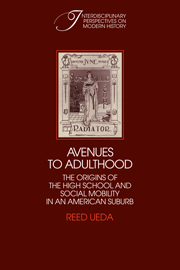Book contents
- Frontmatter
- Contents
- Acknowledgments
- Introduction
- 1 Farm village to commuter suburb
- 2 The evolution of educational leadership
- 3 The free high school
- 4 The rise of Yankee city and the prolongation of schooling
- 5 Popularizing high school: “the college of the people”
- 6 The origins of high school youth culture
- 7 Educational opportunity and social mobility
- 8 The birth of progressive reform and the junior high school
- Conclusion: The high school in the light of history
- Appendix I Courses of study
- Appendix II Sources and methods
- Appendix III Students and households
- Appendix IV Supplementary household data
- Notes
- Index
2 - The evolution of educational leadership
Published online by Cambridge University Press: 04 August 2010
- Frontmatter
- Contents
- Acknowledgments
- Introduction
- 1 Farm village to commuter suburb
- 2 The evolution of educational leadership
- 3 The free high school
- 4 The rise of Yankee city and the prolongation of schooling
- 5 Popularizing high school: “the college of the people”
- 6 The origins of high school youth culture
- 7 Educational opportunity and social mobility
- 8 The birth of progressive reform and the junior high school
- Conclusion: The high school in the light of history
- Appendix I Courses of study
- Appendix II Sources and methods
- Appendix III Students and households
- Appendix IV Supplementary household data
- Notes
- Index
Summary
In mid-nineteenth-century Somerville, the functioning of the common-school system rested unsteadily on growth from a rural community to a dynamic urban society. To secure it on a firmer foundation, the town fathers invented arguments to intensify community support for the schools, recruited able new leaders to manage them soundly, and endeavored to turn a casual collection of amateur teachers into a bureaucracy with a professional ideology and careerist occupational goals. By 1872, when Somerville obtained a city charter, the suburb had developed a permanent civic commitment to the progress of public education, a tradition of strong leadership in the school committee, and a large corps of professionalized teachers, dominated by women, who taught a curriculum that emphasized character training and practical intellectual skills.
The common school and the public interest
The common school was the forge shaping a popular conception of the public interest in Somerville. Because the town's early development was shaped by the common-school movement, educational innovation quickly became the focus of civic affairs.
In 1842, the town's first school committee inherited five ill-maintained schools from Charlestown. Four were primary schools and one was a grammar school. All were located in east Somerville, the densest center of population in the new town. Students spent their first four years in primary school and four more years in the grammar school. School buildings were in very poor condition and the increasing enrollments made the construction of more facilities imperative. The town, therefore, immediately appropriated funds for the construction of two schoolhouses in the following year.
In the winter of 1842 only 68 percent of pupils enrolled in grammar school attended class, although 80 percent of enrolled primary pupils attended.
- Type
- Chapter
- Information
- Avenues to AdulthoodThe Origins of the High School and Social Mobility in an American Suburb, pp. 23 - 39Publisher: Cambridge University PressPrint publication year: 1987



